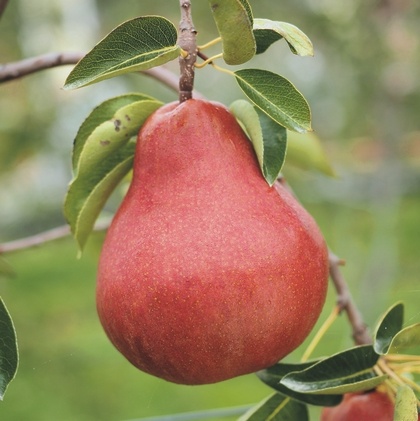Your success is our breeding aim
‘Williams’, ‘Alexander Lucas’, ‘Conference’ – those three varieties have made up the German pear market for decades. Until now, no pear variety was able to compete with those cultivars. Alternatives are more than ever in demand!
The first pear variety originating of the breeding programme of the Bavarian Centre of Pomology and Fruit Breeding comes right on cue. Years of hard selection with the following selection criteria have paid:

Breeder: Dr. Michael Neumüller, Bavarian Centre of Pomology and Fruit Breeding, Hallbergmoos, Germany.
Application for plant variety protection under the name ‘Bay 6474’.
Tree: Weak growth. On quince rootstocks only with interstems. Flower buds mostly terminal on medium long shoots. Lateral branches weak, therefore cutting of the lateral branches at plantation and in the first years recommended. Dense plantation.
Yield: Early starting, high and very regular, rarely alternate bearing. Thinning required. Flowers are relatively frost tolerant according to previous experiences.
Flower: Diploid. Late flowering time. Good pollinator varieties are for example ‘Conference’ and ‘Abate Fetel’.
Fruit: Late to very late ripening, picking about three weeks after ‘Conference’.
80 % of the fruit skin with red overcolour. At picking time brightening of the original violet overcolour.
Winter pear, can therefore not be eaten directly from the tree. Prior to marketing, cold storage for a minimum of three weeks required. It is recommended not to start selling fruits before mid of November.
Fruit large to very large, short-round-conical to conical.
Can be eaten prior to softening. When fully ripe, melting, juicy, sweet and highly aromatic (reminds of ‘Doyonnée du Comice’).
Storage: Stores until mid February in the cold storage (– 1 °C).
CA storage (1.5 % O2, 1.5 % CO2) prolongs storage until May at least; experiments with long-term storage are carried out currently.
Diseases: Until now, only little data for fire blight susceptibility available, therefore no conclusive statement possible. Tolerant to scab.
Rating: Attractive, red skinned winter pear with very good taste. High bearing tree.
